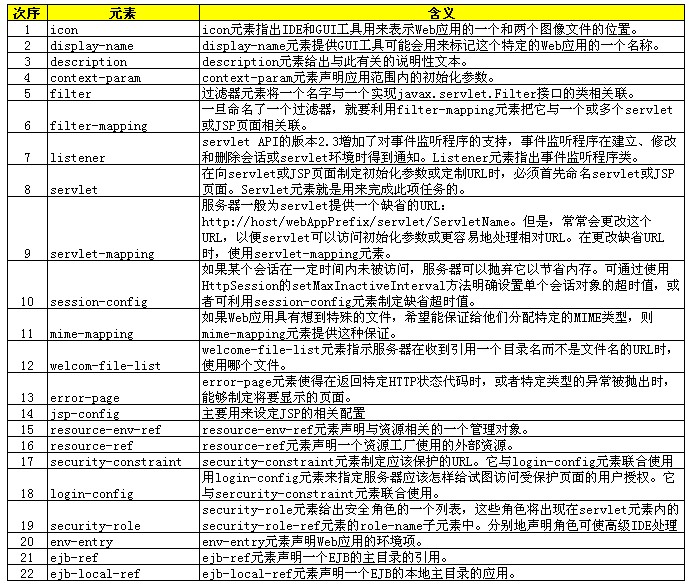引言:
对于涉及J2EE领域的,基本每天都要与Web打交道。那么,Q:什么是Web应用?A:一种可以通过Web访问的应用程序,J2EE领域下,Web应用就是遵守基于Java技术一系列标准的应用程序;那么,又Q:Web应用程序的最大好处是什么?A:用户只需要安装浏览器,不需要其他的软件安装。(B/S架构的优点)
那么,最简单的Web应用是怎样的呢?答案是:2个文件夹,一个xml文件!
第一个文件夹:应用名
第二个文件夹:在第一个文件夹下创建名为WEB_INF的文件夹
XML文件:在WEB_INF文件夹下创建的文件,文件内容只需要<web-app></web-app>
正文:
【 定义 】:
web.xml学名叫做“部署描述符文件”,是在Servlet规范中定义的,是web应用的配置文件。
【 规范 】:必须以一个XML头开始,这个头声明可以使用的XML版本并给出文件的字符编码。DOCTYPE声明必须立即出现在此头之后。这个声明告诉服务器适用的Servlet规范的版本,并指定管理此文件其余部分内容的语法的DTD。所有部署描述符文件的顶层元素为web-app。另外一定要注意,XML是大小写敏感的!!!
web.xml示例:
<?xml version="1.0" encoding="UTF-8"?>
<web-app xmlns:xsi="http://www.w3.org/2001/XMLSchema-instance" xmlns="http://java.sun.com/xml/ns/javaee" xsi:schemaLocation="http://java.sun.com/xml/ns/javaee http://java.sun.com/xml/ns/javaee/web-app_2_5.xsd" id="WebApp_ID" version="2.5">
</web-app>另外,web.xml中的XML元素不仅是大小写敏感的,而且它们还对出现在其中的元素的次序敏感。例如,XML头必须是文件的第一项,DOCTYPE声明必须是第二项,web-app必须是第三项。在web-app元素内,元素的顺序也很重要。服务器不一定强制要求这种次序,但它们允许完全拒绝执行含有次序不正确的元素的Web应用。这表示使用非标准元素次序的web.xml文件是不可移植的。
【 元素顺序列表 】:

【 元素标签详解 】:
1.<icon>
含义:icon元素包含两个子元素:small-icon和large-icon,用来指定web站台中小图标和大图标的路径。图像文件必须是GIF或者JPEG。
示例:
<icon>
<small-icon>/images/small.gif</small-icon>
<large-icon>/images/large.gif</large-icon>
</icon>
2、3.<display-name>、<description>
含义:display-name定义应用的名称,description对应用做出描述。
示例:
<display-name>TestServlet</display-name>
<description>测试Servlet</discription>4.<context-param>
含义:设定web应用的环境参数,它包含两个子元素:param-name和param-value,分别表示参数名称和参数值。
示例:
<context-param>
<param-name>e-mali</param-name>
<param-value>727291706@qq.com</param-value>
</context-param>String param_value=getServletContext().getInitParamter("e-mail");5、6.<filter>、<filter-mappinp>
含义:<filter>用来设定Web应用的过滤器,它包含两个子元素:filter-name和filter-class,用来定义Filter所对应的类和实例名称;<filter-mapping>包含两个子元素:filter-name和url-pattern,用来定义Filter所对应的URL。两个filter-name要一致,且一个<filter>对应一个<filter-mapping>
示例:
<filter>
<display-name>MessyCodeFilter</display-name>
<filter-name>MessyCodeFilter</filter-name>
<filter-class>cc.lewa.MessyCodeFilter</filter-class>
<init-param>
<param-name>encoding</param-name>
<param-value>UTF-8</param-value>
</init-param>
</filter>
<filter-mapping>
<filter-name>MessyCodeFilter</filter-name>
<url-pattern>/*</url-pattern>
</filter-mapping>7.<listener>
含义:定义Listener接口,它的主要子元素为<listener-class>,用来定义Listener类的名称。
示例:
<listener>
<listener-class>org.springframework.web.context.ContextLoaderListener</listener-class>
</listener>8、9.<servlet>、<servlet-mapping>
含义:servlet元素的两个主要子元素servlet-name和servlet-class用来定义servlet所对应的类;servlet-mapping元素包含两个子元素servlet-name和url-pattern.用来定义servlet所对应URL.
示例:
示例:
<servlet>
<description></description>
<display-name>MessyCodeServlet</display-name>
<servlet-name>MessyCodeServlet</servlet-name>
<servlet-class>cc.lewa.MessyCodeServlet</servlet-class>
</servlet>
<servlet-mapping>
<servlet-name>MessyCodeServlet</servlet-name>
<url-pattern>/MessyCodeServlet</url-pattern>
</servlet-mapping>10.<session-config>
含义:session-config包含一个子元素session-timeout,定义这个Web站台所有Session的有效时间,单位分钟。
示例:
<session-config>
<session-timeout>30</session-timeout>
</session-config>
11.<mime-mapping>
含义:mime-mapping包含两个子元素extension和mime-type,分别定义某一个扩展名和某一MIME Type做对映。
示例:
示例:
<mime-mapping>
<extension>doc</extension>
<mime-type>application/vnd.ms-word</mime-type>
</mime-mapping>
<mime-mapping>
<extension>xls</extension>
<mime-type>application/vnd.ms-excel</mime-type>
</mime-mapping>
<mime-mapping>
<extension>ppt</extesnion>
<mime-type>application/vnd.ms-powerpoint</mime-type>
</mime-mapping>12.<welcome-file-list>
含义:用来定义首页列单,welcome-file-list包含一个子元素welcome-file,用来指定首页文件名称。
示例:
<welcome-file-list>
<welcome-file>index.jsp</welcome-file>
<welcome-file>index.htm</welcome-file>
</welcome-file-list>
含义:error-page元素包含三个子元素error-code,exception-type和location.将错误代码(Error Code)或异常(Exception)的种类对应到web应用资源路径。
示例:
示例:
<error-page>
<error-code>404</error-code>
<location>/error404.jsp</location>
</error-page>
<error-page>
<exception-type>java.lang.Exception</exception-type>
<location>/exception.jsp</location>
</error-page>14.<jsp-config>
含义:用来设定JSP的相关配置,包括<taglib>和<jsp-property-group>两个子元素。
示例:
<jsp-config>
<taglib>
<taglib-uri>Taglib</taglib-uri>
<taglib-location>/WEB-INF/tlds/MyTaglib.tld</taglib-location>
</taglib>
<jsp-property-group>
<description>
Special property group for JSP Configuration JSP example.
</description>
<display-name>JSPConfiguration</display-name>
<uri-pattern>/*</uri-pattern>
<el-ignored>true</el-ignored>
<page-encoding>GB2312</page-encoding>
<scripting-inivalid>true</scripting-inivalid>
</jsp-property-group>
</jsp-config>
含义:resource-env-ref有两个子元素:resource-env-ref-name和resource-env-ref-type,分别用来指定资源的名称和查找资源时返回的资源类名。
示例:
<resource-env-ref>
<resource-env-ref-name>jdbc/mssql</resource-env-ref-name>
<resource-env-ref-type>javax.sql.DataSource</resource-env-ref-type>
</resource-env-ref>16.<resource-ref>
含义:resource-ref元素包括五个子元素description,res-ref-name,res-type,res-auth,res-sharing-scope.利用JNDI取得应用可利用资源。
示例:
<resource-ref>
<description>JNDI JDBC DataSource</description>
<res-ref-name>jdbc/data</res-ref-name>
<res-type>javax.sql.DataSoruce</res-type>
<res-auth>Container</res-auth>
</resource-ref>





















 242
242

 被折叠的 条评论
为什么被折叠?
被折叠的 条评论
为什么被折叠?








